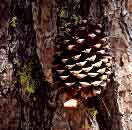
Cone and bark on a tree west of Sonora Pass, California [C.J. Earle].
Common Names
Jeffrey, bull, western black, Truckee or sapwood pine (3).Taxonomic notes
Syn: Pinus deflexa Torrey 1859; P. jeffreyi var. deflexa (Torrey) Lemmon 1888; P. ponderosa var. jeffreyi (Balfour) Vasey 1876; P. ponderosa ssp. jeffreyi (Balfour) Murray 1982; P. jeffreyi var. baja-californica Silba 1990 (11).Description
Trees 24-39(61) m tall, diameter 60-120(250) cm diameter, usually straight; crown conic to rounded. Bark yellow-brown to cinnamon, thick, deeply furrowed and cross-checked, forming large irregular scaly plates, with odor of lemon and vanilla during the growing season. Branches spreading-ascending; twigs stout (to 2 cm thick), purple-brown, often glaucous, aging rough. Buds ovoid, tan to pale red-brown, 2-3 cm, not resinous; scale margins conspicuously fringed. Needles 3 per fascicle, spreading-ascending, persisting (2)4-6(7) years, 12-22(25) cm × ca. 1.5-2 mm, slightly twisted, gray- to yellow-green, all surfaces with fine stomatal lines, margins finely serrulate, apex acute to acuminate; sheath (1)1.5-2.5(3) cm, base persistent. Staminate cones lance-cylindric, 20-35 mm, yellow to yellow- or purple-brown or yellow. Ovulate cones maturing in 2 years, shedding seeds and falling soon thereafter, nearly terminal, spreading, slightly asymmetric at base, ovoid-conic before opening, cylindro-ovoid when open, (10)15-30 cm, light red-brown, nearly sessile or on stalks to 0.5 cm, abaxial surface of scales not darker than or sharply contrasting in color with adaxial surface, scales in low spirals (as compared to Pinus ponderosa ) of 8 or more per row as viewed from side, those of cones just prior to and after cone fall not so spreading and deflexed, thus not so much separated from adjacent scales; apophyses slightly thickened and raised, not keeled; umbo central, slightly raised, with short, slender, reflexed prickle. Seeds ellipsoid-obovoid; body ca. 1 cm, brown or gray-brown, mottled darker; wing to 2.5 cm. 2 n =24 (4, 7).Range
US: SW Oregon, S through the Klamath Mtns. and Sierra Nevada of California and far W Nevada into Mexico: N Baja California Norte, at (1000)2000-3100 m on dry mountain slopes (4, 7). See also (13). A characteristic species of serpentine and other nutrient-poor soils.Big Tree
Diameter 247 cm, height 58.5 m, crown spread 27 m, located in Stanislaus National Forest, CA (8, 9). Also, height 70.1 m, in Sequoia National Park, CA (9).Oldest
Two tree-ring chronologies, nased on living tree material, have lengths of 661 and 663 years, respectively. The first was collected in 1964 at Tioga Pass, California (2591 m elevation, 37° 57'N, 119° 9' W) by C.W. Ferguson and M.L. Parker; the second was collected at Blue Banks, California (1598 m elev., 39° 40'N, 122° 58'W) by R.L. Holmes et al. in 1980 (12).Dendrochronology
Brubaker and Graumlich have developed a number of chronologies from the Siskyou area, and Holmes et al. (5) have published several chronologies from the Sierra Nevada.Ethnobotany
Observations
Seen at many locations in California, Oregon, and in the Sierra San Pedro Martir of Baja California Norte. I think the last is the most memorable. An extraordinarily extensive old-growth forest cloaks the upper elevations (above about 2000 m) of this Mexican National Park, with extensive open stands of Jeffrey and sugar ( P. lambertiana ) pine interspersed with white fir ( Abies lowiana ). Locally the forest opens out into parks fringed by lodgepole pine ( P. contorta ), and rocky, exposed outcrops have specimens of the endemic Cupressus arizonica var. montana . The park is readily accessed from the west by a good gravel road that leaves the Transpeninsular Highway 140 km S of Ensenada and services an astronomical observatory situated near the summit of the Sierra.Remarks
Named for its discoverer, John Jeffrey, a 19th century Scots botanist who traveled in OR and CA (4). See the Remarks section of P. balfouriana (which he also discovered) for some of Jeffrey's story." Pinus jeffreyi has a form very similar to that of P. ponderosa , but it is a smaller species when compared with sympatric populations of the latter. It is cut and sold under the same name as P. ponderosa , but the sweetish odor of the fresh-cut wood contrasts sharply with the turpentine odor of ponderosa pine. The resin chemistry of the two species is significantly different" (7). The sap contains heptane, a highly flammable hydrocarbon that was at one point used in developing the octance scale for grading gasolines (6).
Ponderosa pines ( P. ponderosa ) were used for turpentine extraction in late 19th century California. In the absence of cones, the two species resemble each other rather closely and occur in mixed stands. Occasionally workers would try to distill turpentine from Jeffrey rather than ponderosa sap, with explosive and sometimes tragic consequences (6).
Citations
(1) Silba 1986 .(2) Arno & Gyer 1973 .
(3) Peattie 1950 .
(4) Little 1980 .
(5) Holmes et al. 1986 .
(6) Mirov & Hasbrouck 1976 .
(7) Robert Kral in Flora of North America online .
(8) American Forests 1996 .
(9) E-mail communication from Robert Van Pelt, who measured these trees; 18-Mar-1998.
(11) Farjon & Styles 1997 .
(12) Data accessed at the NOAA Paleoclimatology Program Tree-Ring Data Search Page, 24-Feb-1999. URL: http://julius.ngdc.noaa.gov/paleo/ftp-treering.html .
(13) Robert S. Thompson, Katherine H. Anderson and Patrick J. Bartlein. 1999. Atlas of Relations Between Climatic Parameters and Distributions of Important Trees and Shrubs in North America. U.S. Geological Survey Professional Paper 1650 A&B. URL= http://greenwood.cr.usgs.gov/pub/ppapers/p1650-a/pages/conifers.html , accessed 22-Jan-2000.
See also:
Burns & Honkala 1990
.
Elias 1987
.
Lanner 1983
.
FEIS database
.
The Ecological Role of Fire in Sierran Conifer Forests
.
[ Pinus ] [ Pinaceae ] [ home ]
This page is from the Gymnosperm Database
URL: http://www.geocities.com/~earlecj/pi/pin/jeffreyi.htm
Edited by Christopher J. Earle
E-mail:
earlecj@earthlink.com
Last modified on 28-Jan-2000